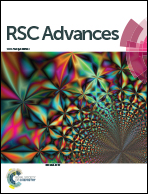α(β)-PbO2 doped with Co3O4 and CNT porous composite materials with enhanced electrocatalytic activity for zinc electrowinning†
Abstract
The high energy consumption during zinc electrowinning is mainly caused by the high overpotential of the oxygen evolution for Pb–Ag alloys with strong polarization. The preparation of new active energy-saving materials has become a very active research field, depending on the synergistic effects of active particles and active oxides. In this research, a composite material, α(β)-PbO2, doped with Co3O4 and CNTs on the porous Ti substrate was prepared via one-step electrochemical deposition and the corresponding electrochemical performance was investigated in simulated zinc electrowinning solution. The composite material showed a porous structure, finer grain size and larger electrochemical surface area (ECSA), which indicated excellent electrocatalytic activity. Compared with the Pb–0.76 wt% Ag alloy, the overpotential of oxygen evolution for the 3D-Ti/PbO2/Co3O4–CNTs composite material was decreased by about 452 mV under the current density of 500 A m−2 in the simulated zinc electrowinning solution. The decrease in the overpotential of oxygen evolution was mainly ascribed to the higher ECSA and lower charger transfer resistance. Moreover, it showed the lowest self-corrosion current density of 1.156 × 10−4 A cm−2 and may be an ideal material for use in zinc electrowinning.



 Please wait while we load your content...
Please wait while we load your content...